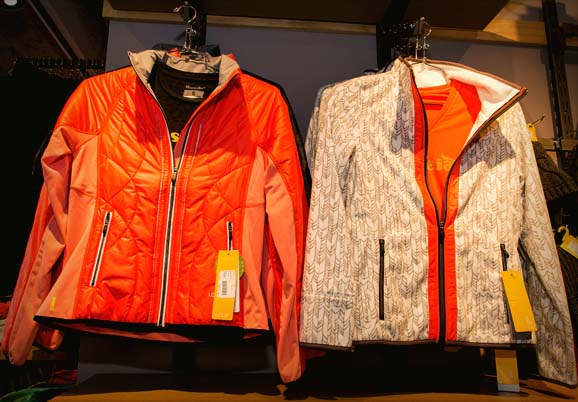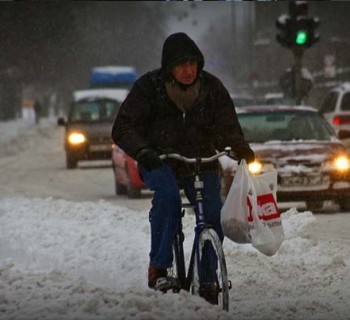Editor's Note: This is part two of a two-part series on winter biking. Though it's a billion degrees below zero lately, most winter cycling can be done easy enough in any weather with just the right gear.
For a winter cyclist, the right set of clothes can mean the difference between a tolerable ride or complete misery.
In addition to chilly temperatures, riders often face challenges like snow, ice and brutal winds. Dressing for these conditions, however, doesn't necessarily mean bundling up like an arctic explorer.
 Mike Torres is a Detroit bike mechanic who relies on his bike as his primary mode of transportion. When wintertime rolls around, though, you won't see him zipping around town in a heavy winter coat.
Mike Torres is a Detroit bike mechanic who relies on his bike as his primary mode of transportion. When wintertime rolls around, though, you won't see him zipping around town in a heavy winter coat.
"All I wear is a rain suit. You're trying to get the wind off, cause you'll create heat while riding. It's really not as bad as one thinks at all," he tells Mode Shift. "Basically what you need to do is layer up."
Besides the rain suit, he usually wears a good pair of hiking boots and matches the rest of his outfit with the day's weather conditions.
"I usually have a pair of Levi's on," he says. "If it's really nasty, I'll put a pair of Columbia rain pants on and then usually some type of polypropelene long john's top and bottom. Sometimes I'll just wear a waffle top on top, depending how cold it is, and then usually a T-shirt [or] sweatshirt."
Leslie Wacker, another dedicated winter cyclist and Detroit resident, agrees with Torres on the virtues of multiple layers.
"Layering, if you're down with wearing animal fibers, wool is incredible," she says. "Covering your ears, covering your neck, covering your core. Sometimes I'll get along in the winter with a really warm dress, if it's not too bad out, a sweater. Blocking the wind is important."
Wacker, who builds cargo bikes under the name Freighty Cat with her partner Kyle Wiswall, says it's really important to close the gap between one's shirt and pants, since when a rider bends over that area is often exposed to the wind.
She also wears gloves and recommends paying special attention to one's feet. Her advice is to wear warm socks, ideally wool, and thick-soled wind-proof footwear.
 "Boots are better than shoes," she says, "but steel toes are a terrible idea because they trap the cold and hold it close to your feet. Don't wear rain boots. They provide no warmth and the sheer number of socks you would need to compensate will just give you sweaty feet, and nobody wants that."
"Boots are better than shoes," she says, "but steel toes are a terrible idea because they trap the cold and hold it close to your feet. Don't wear rain boots. They provide no warmth and the sheer number of socks you would need to compensate will just give you sweaty feet, and nobody wants that."
Both cyclists advise riders to be safe and wear a helmet, preferably over a winter hat.
When it comes to local shopping for winter gear, Torres recommends his own store, the Downtown Detroit Bike Shop, for accessories and the Moosejaw store downtown for clothing like a rainsuit. Along with Moosejaw, Wacker also suggests a less costly alternative.
"Go to Salvation Army," she says. "Any thrift store you can find a ton of [clothes]. You can pretty much get head-to-toe wool for tens of dollars."
Here's a listing of some Detroit stores where cyclists can buy their winter gear while supporting local businesses:
Meijer, 1301 W 8 Mile
Moosejaw, 1275 Woodward
National Dry Goods, 1200 Trumbull
Salvation Army, 1200 W Fort St
Value World, 8300 Woodward
What are your tips for winter riding? Share them in our comments below.










